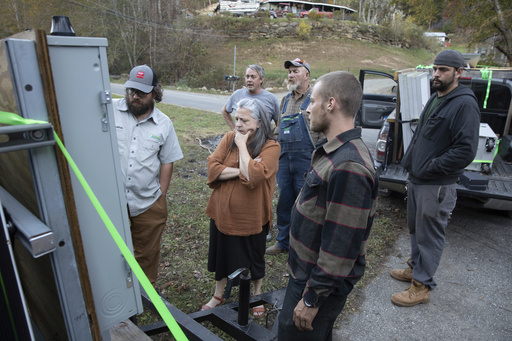
BAKERSVILLE, N.C. — In the wake of Hurricane Helene’s destruction, which decimated power lines and obliterated roads throughout North Carolina’s mountainous regions, Bobby Renfro finds himself overwhelmed by the incessant noise of a gas-powered generator. Renfro has transformed a former church in Tipton Hill into a community resource center for local residents, yet the din makes it hard to communicate with the stream of nurses, neighbors, and volunteers that come through the door. The financial burden is also staggering; he invested $1,200 to purchase the generator and has incurred significant ongoing expenses for fuel, which volunteers are transporting in from neighboring Tennessee.
Shutting off this vital power source is simply not an option. This generator is essential for maintaining a refrigerator that stores insulin for diabetic residents, as well as operating oxygen machines and nebulizers that others depend on for survival. Renfro, a retired railroad worker, expresses concern that outsiders may not grasp the gravity of their situation, especially as they remain trapped without electricity on elevated terrains and in remote valleys. “We have no resources for anything,” he lamented. “It’s going to be a long ordeal.”
As of Friday, more than 43,000 of the 1.5 million customers who lost power in western North Carolina were still without electricity, according to Poweroutage.us. The loss of power severely hampers their ability to keep medications refrigerated, operate medical devices, or access well water. The situation also complicates simple tasks like charging cell phones or applying for federal disaster assistance. Repair crews from across the United States and even Canada are assisting Duke Energy and local cooperatives, but the repairs are proceeding at a slow pace due to the challenging terrain, where some routes and bridges have been entirely washed away. “The crews aren’t doing what they typically do,” noted Kristie Aldridge, vice president of communications at North Carolina Electric Cooperatives. “They’re rebuilding from the ground up.”
For those fortunate enough to find gas or diesel generators, reliance on them is rife with challenges. Fuel prices are high and often require long trips to secure. Furthermore, the fumes generated can be harmful or even lethal. Small generators aren’t designed for extended use, and in many cases, residents find themselves relying on them for weeks or even longer.
Fortunately, relief is beginning to arrive. Renfro received a new, cleaner, and quieter power supply this week. Volunteers from the nonprofit Footprint Project, along with a local solar installation company, delivered a solar generator equipped with six 245-watt solar panels, a 24-volt battery, and an AC power inverter. These solar panels have been set up on a grassy area outside his community center, allowing Renfro to offer a degree of comfort and electricity to his neighbors.
The Footprint Project is expanding its emergency response efforts by implementing sustainable mobile power systems. So far, they have deployed several larger solar microgrids and solar generators, along with machines capable of extracting water from the air, to 33 locations. They are also working to source hundreds of additional portable batteries and larger systems, including industrial-scale solar generators referred to as “Dragon Wings.”
Will Heegaard and Jamie Swezey, the husband-and-wife duo that founded the Footprint Project, aim to lower the carbon footprint of emergency responses. Heegaard started the organization in 2018 in New Orleans, and while the destruction caused by Helene is significant, Swezey noted their focus now primarily revolves around augmenting existing generator use instead of outright replacements. “I’ve never seen anything like this,” she remarked, considering the extensive list of requests and volunteers compiled on a whiteboard. “It’s all hands on deck with whatever you can use to power whatever you need to power.”
In Mars Hill, a warehouse owner has generously offered their space to Swezey and Heegaard, allowing them to operate and rest inside. Each day, they sort through numerous messages across the region, responding to requests ranging from individuals needing power for oxygen machines to community hubs in need of supplies. Local contributors, like Hayden Wilson and Henry Kovacs—who traveled from Asheville to assist—have also been pivotal in this initiative.
Meanwhile, Julie Wiggins runs a community hub from her driveway in Bakersville, offering support to around 30 families. Many of her neighbors faced significant difficulty reaching her, having to navigate through fallen trees. Some resorted to placing their insulin in nearby creeks for cooling. Recently, the Footprint Project supplied Wiggins with solar panels and a battery that now power her small refrigerator, a water pump, and a Starlink communication system. “This is a game changer,” she expressed.
The volunteers continued their journey, stopping at Renfro’s hub before heading to a nearby church that has relied on two generators. Other locations remain difficult to access. Heegaard and Swezey even explored creative ways to transport batteries to higher elevations, including the use of mules and helicopters. Their experiences remind them of past challenges, as Heegaard previously volunteered in Puerto Rico after Hurricane Maria, where communities endured extensive outages lasting nearly a year. Duke Energy crews are applying methods learned in Puerto Rico, including using helicopters to drop new utility poles into hard-to-reach areas.
The most challenging cases involve residences suffering extensive damage, leaving utility crews unable to restore connections. Swezey emphasized that the Footprint Project is committed to remaining in the area for as long as necessary, recognizing that some residents will require assistance long after traditional power is restored. “We know there are people who will need help long after the power comes back,” she affirmed.
